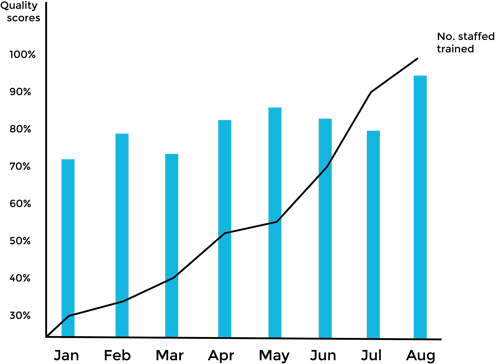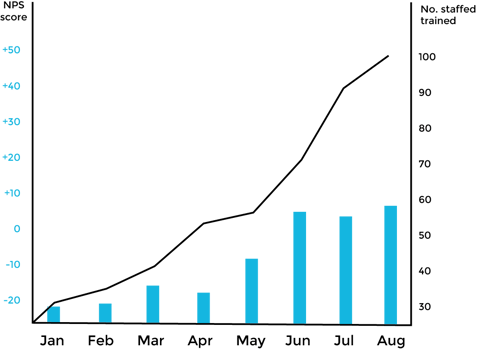-1.png?width=1920&name=Untitled%20design%20(1)-1.png)
So here we are again, time to create a learning strategy. This is going to be epic! We’ll bring in new platforms, create game based learning, videos, blogs, oooh...what about a cool learning area where people can sit on big sofas, funky wallpaper, a TV with company news and large inspirational quotes on the walls; everyone will love that. Is an ‘engagement candy floss’ machine a thing? Let’s make sure we get a budget for VR; that’s hot at the mome….
STOP! Please stop.
Ok this is an exciting time for you. Yes I said it, strategies can be fun. It’s a chance to shape the future of how people learn in your business, to make a real impact on performance and behaviours. But it can be easy to get distracted by the latest trends, trending topics and the possibility of cool new tech.
I’ll be the first to say it; it can be tricky knowing where to start, especially when people are saying we need a better ‘blended approach’. And when you ask for clarity on what their definition of blended is you’re met with ‘’you know, more options; blended’’ *bangs head on desk*. The other side to this is how big should you go? What are the right things to implement, or remove in some cases? Should the content you create be part of your strategy or just how it’s all presented?
Here’s 7 tips (don’t worry there will be more down the line) on how to create a learning strategy that doesn’t suck. By this I mean it’s not just for show, but for impact and change.
Tip 1 – Have a clear vision and purpose for your learning strategy
The starting point is to always define what your vision is - start with the why. This needs to line up with what your business is trying to achieve. Let’s say for example your business is trying to improve customer loyalty and its brand reputation. Your starting point here is why does the company have a bad rep and poor customer loyalty?
We’ll look at the specifics of how to analyse with a learning lens later in the blog, as doing so helps your vision for your strategy become clearer – We need our people to be brand advocates, provide world class service and be great communicators. This means every decision you make in your strategy, short term and long term, needs to work towards this vision and purpose. If it doesn’t add value or push this goal forward, then it has no place in the final plan.
Everything is always about context. Something that has worked for other businesses might not work for you. So, this isn’t about saying which learning method and tech do or don’t work; but which ones do and don’t work for your business and people.
Tip 2 – Data is key to achieving learning success
You’ve likely heard this over and over about the power of data, but it’s true. Use data to identify where skills or knowledge gaps are stopping you achieving your end goal. This insight will also help shape that vision we spoke about in tip 1. I won’t go too indepth about data and return on investment (ROI) as we have a whole other blog for that. What I will call out though, are two essential things:
1. Make sure you use actionable metrics and not vanity metrics
Vanity metrics are ones that sound or look useful, and might be great for others business needs, but don’t help measure performance of your strategy and activities. Let’s go back to our example of your business wanting to improve customer loyalty and it’s brand reputation. You’ve introduced several customer service and soft skills eLearning modules for all staff to complete as refreshers. They’re also included in new starter inductions, supported by listening to previous live calls to discuss what went well, or could be improved.
Vanity metrics here would be:
- The number of people who have completed the training
- Quality assurance audits that mark calls against a predefined soft skills quality criteria
The reason these are vanity metrics is because although these might look great and show improvement, they don’t show improvement of the desired performance (customer loyalty and brand reputation)

Some actionable metrics here might be (assuming they are available):
- NPS metrics (Net Promoter Score) - this metric tells a company whether someone is likely to be loyal to the brand and is an advocate
- CSAT scores (Customer satisfaction) - these tell you how the customer feels about the service (although this one is still a little ambiguous as it depends at what point the question is sent)

Overall, these metrics are the ones that truly show whether your learning is being successful in this scenario. That’s not to say don’t track the others, as they can give great insight into how to adapt and change the learning to make it even better. But in these two graph examples you can see the QA scores look like success (71% increasing steadily to 93%), however the true metrics for us here shows a stagnation in improvements (sitting around +5 after improving from -23) despite a rapid increase in the number of staff trained. This means you’ve either peaked or further analysis is needed to see what else needs to happen to improve customer loyalty and brand reputation. And FYI, this might not even be a training issue but something else like call wait times.
2. Turn your people’s insight, thoughts and feelings into data
The way to do this is to talk to your people. Send out surveys to find out what they like, don’t like or feel they need as part of their learning. Observe people completing the tasks that are related to the issues; you might find that it’s not a soft skill issue, but that technology or processes also stand in the way.
By converting people’s thoughts and feelings into data, it backs up any hard business metrics to get to the real issues and build a strong case for anything you pitch to senior leadership. For example, you might also find that 80% of your workforce really like video-based training and want to be able to access cheat sheets and helpful tips quickly. This means you’ve got a stronger case to ask for a budget for video equipment and the need to create a knowledge base, not just have the current LMS.
Remember that feelings don’t make business decisions, facts do. So turn feelings into facts.
Tip 3 – Include others in your learning strategy design
We’ve already mentioned about including your end audience in the data stages, but you should also work out who else in the business needs to be involved and linked into your plans. You might need help from your communications team to promote and launch any new systems. Maybe team managers need to be in the loop to know what’s coming down the line for their people and give them support to help the adoption of new solutions.
The great thing about putting your plans out to the whole business (once your strategy is signed off of course) is it holds both you and the business accountable to deliver what’s been promised.
Also, when including others, ask your people what they think about the existing L&D offering. Yes, this will be scary as it will shine a light on your team. But this isn’t to criticise; it’s gaining insight from your end users. Figure out what they want and dream of for their development and support. It’s not to say you will do everything they ask but find the trends and build those into your strategy.
Tip 4 – Change your plans if you need to
Now this might seem a little contradictory to the above tip as I’ve just mentioned it holds you accountable to deliver something. But your overall vision shouldn’t change unless there’s a big shift in the overall business goals.
So, what I mean here is track those actionable metrics as you go, don’t just wait until the end of your 12 month strategy to check if it’s been successful. Be agile. If the content isn’t working, change it and try something else. If you’ve bought new technology and people aren’t using it, change your comms and marketing plans; you might need to look at how you’ve set the platforms up and the interface you’ve designed.
You’re still working towards the same goal but you’re being proactive in dealing with issues. It’s easier to solve smaller problems as you go than bigger problems down the line.
Tip 5 – Don’t forget your learning content
A strategy isn’t all about new tech and ways of packaging up L&D solutions to the business. Yes, you can turn that workshop into eLearning, convert your facilitator guides into resources or move to a virtual classroom; but just because you package up the same content in a different medium doesn’t mean it’s going to be more successful.
As part of any strategy, always look at the content of your learning solutions. It’s easy to fall into the trap of using all the existing material available or using rapid deployment authoring tools to quickly make some of it eLearning - maybe a few TED Talks here and there with a sprinkle of face to face training using Zoom (or that alike).
Why is it easy to fall into this trap? Well, it’s quicker and looks good on paper. And I’ll be the first to admit I’ve made this mistake in the past as well! Again, this goes back to vanity metrics. It doesn’t matter if you’ve managed to get 50 eLearning courses available in 2 months or now have all face-to-face training online for people to self-enroll. These metrics aren’t actionable. If those solutions resulted in X business performance improving, then great, you’ve done the right thing. But tell that story with data, not the vanity ones.
Look at the content you’re putting out to the business and make sure that your learning content is relevant, compelling, contextual, and accessible.
Relevant – Your learning needs to be relevant to the job, skill, action, or behaviour of the end user. GDPR is a great example here. Someone talking to customers on the phone doesn’t need to be able to recite the 9 principles of GDPR. They need to know how to apply those principles in their job; such as asking the correct security questions or keeping data locked away.
Compelling – Make sure the learning available is relatable and compelling to the audience. Storytelling and real-world examples are great to use here. Again though, only if they link to the end user. For example, having an example of a member of staff leaving their laptop on the train with lots of customer data causing a massive GDPR breach, in your learning, is only really compelling if you’re a laptop user. Ok, we can’t have examples for every member of staff or job role, but this goes back to is your ‘one size fits all’ global solution the right one to get the right results?
Contextual – Learning is about context, right? The classic example I use here is systems training. Do your people know how to complete a process by just clicking the correct buttons, or do they complete it and know why they are clicking a button, why they’re completing a process or why they’re asking for X information. Where possible make learning match the real world of the end user and get them to make decisions and get feedback specific to the decisions they’ve made. Make your learning a ‘safe place to fail’.
Accessible – There’s two sides of the coin here. Making learning accessible to complete and making it accessible to all people regardless of environment, situation, or ability.
Spend time setting up your platforms or systems where people are accessing content. Consider ways to reduce friction with less clicks to get to content. Direct hyperlinks in comms. Meaningful tagging of content and the whole content architecture. Does your platform match how you would like it to look or match that of the end users’ perception of where content should be? If the two aren’t in harmony, there’s an issue.
Accessible learning isn’t a ‘nice to have’ it’s a ‘must have’. Accessibility isn’t just about disabilities, it’s about adding value to peoples’ learning experience. For example, if someone is in a busy office and trying to listen to a video or audio, subtitles massively help how accessible that content is. Everyone has the right to learn so make sure accessibility is a big focus in your strategy.
Tip 6 – The world doesn’t stop for learning
Whilst long term visions and goals are vital for continuous improvement in a business, the world doesn’t stop. People will still need to go about their jobs as normal. Consider then, your short term and long-term activities. What can be done now to support people and the business. Just remember even your short-term activities need to contribute towards your longer vision.
Let’s go back to our example again. In the scenario, your business has little training available on soft skills and customer service techniques; and what you do have is very dated. Your long-term plans are to create specific short videos that can be accessed on a new LXP, as your existing LMS is very old and tired. To start fixing this issue using short term strategies you’ve purchased some off the shelf eLearning on these two topics for people to start using now. You’ve opted for this as clearly the existing content isn’t effective so there’s no point shifting to the new platform. You’ll review the effectiveness of these new courses in your long-term plans because if these have the desired improvement, there’s no need for those video ones you've planned out long term – they wouldn’t add value in this case.
I would highly recommend that if you're bringing in new technology, such as LXP’s or social platforms, you go with a lean design approach and utilise MVPs (minimal viable products) to begin with. MVP’s are about creating the smallest product needed that still solves the key end user problems. For example, launching a new LXP with some soft skills content, notifications, and manual log-in will help get your learning out sooner. However, it would be the wrong MVP (in our example) if you launched with existing process training, engagement surveys and single sign on integration as these don’t help solve the problem of improving brand reputation and customer loyalty. There’s a link at the end of this blog to help with defining and creating MVP’s.
Tip 7 – Keep reviewing your learning strategy
It’s great when you and your team have implemented and changed lots of things. When you start seeing the results too it really is a great feeling knowing your strategic and short-term efforts have contributed towards people’s success and business growth. But don’t stop there. A strategy shouldn’t just be a 12-month project and then life goes on. Keep it going. What can be refined, tweaked? What’s next to improve?
Final thoughts
There’s clearly plenty to think about when creating your next learning strategy but hopefully this has given you plenty of food for thought.
My final piece of advice is, become a great storyteller. Yes, we hear this a lot now but it’s true. You could create the world's best strategy with everything right, but if you can’t tell the story of how these activities, ideas, money needed, and tech will improve the state of play then inevitably it will get changed, warped, or turned down.
‘’You could have the best idea in the world, but if you can’t sell that idea, if you can’t get that idea into peoples’ heads - then you really have no idea at all.’’ – James Whittaker, The Art of Stage Presence.
If you’re in the process of building your own learning strategy and would like to run some ideas past another learning professional, feel free to reach out to Phill for a quick no-obligation chat.
Links to further reading
iAM Learning ROI blog: https://www.iamlearningcontent.com/blog/how-to-demonstrate-roi-with-learning-solutions
Minimum Viable Product article: https://www.productplan.com/glossary/minimum-viable-product/
Vanity metrics article: https://www.productplan.com/glossary/vanity-metrics/
-1.png)

.jpg)
.png)
